Cozy little shop in Buda Texas. Opening weekend May 10th and 11th, 10 am to 6 pm.
503 S. Loop 4, Buda, TX 78610. https://maps.app.goo.gl/Y573d6GAMjcwBPsb8
Fiber Fate is a specialty shop adjacent to historic downtown Buda. Yarn + Fiber + Spinning. Shop lots of fiber and yarn related things in this unique space – Fiber Fate hand-dyed & handspun yarn, spinning/felting fiber, spinning wheels and accessories. Notably, I’ll have spinning wheels by Schacht, Louet, Ashford, and Majacraft. Not to mention, bags, books, stitch markers, and crafting kits. Classes too! Sign-up for an in-person class. Classes start Sunday May 19th and will typically be held Sundays and Mondays. Class signup and descriptions HERE
See you at the shop soon!

What a fantastic start to 2023. Since March I’ve met so many new fiber people. It has been incredibly nice to meet each of you, hear about your fiber spinning and processes, and share a little bit of Fiber Fate with you. We met at Bandera Fiber & Arts Festival, Farm to Needle, Yellow Rose and Wimberley Market Days. I am looking forward to keeping in touch and meeting more of you fiber lovers and makers throughout the year. Thank you for all the encouragement and inspiration!
Creating more opportunities for us to meet. I am very excited for all the shows and teaching I’ve been able to participate in this year. I’ll be at Houston Fiber Festival for the first time in June. Head to Kerrville for Texas Fleece & Fiber Festival (previously Kid n’ Ewe) in October. I will be announcing and posting about a few other opportunities as plans solidify. And don’t forget, there’s always Wimberley Market Days the 1st Saturday of each month (July is iffy at this point). Check-in at my Shopping/Events page to see current details on where we can meet in person.
Fiber Fate Shop Announcements:
As of March, I am an official member of The Livestock Conservancy. Currently I have 2 handspun yarns (Leicester Longwool) and several commercially processed fibers (Shetland, Jacob, Black Welsh Mountain) available and ready that will fulfill passport requirements. Behind the scene, I have four types of fleece being hand processed for upcoming fiber and yarn sales (Teeswater, Jacob, Shetland, and Churro).
In April, I became a proud supplier of Eucalan wool & laundry delicate wash. I have been using Eucalan regularly for well over 10 years. As you can imagine, with the creation of Fiber Fate a few years ago, it has been an especially useful tool in the production of my yarns. I use it on all my handspun and hand dyed yarns in the finishing stage. I’ll have that available online very soon. Feel free to contact me directly via email if you are in dire need. I’m happy to deliver locally, and pop it in the mail otherwise.
See you soon!
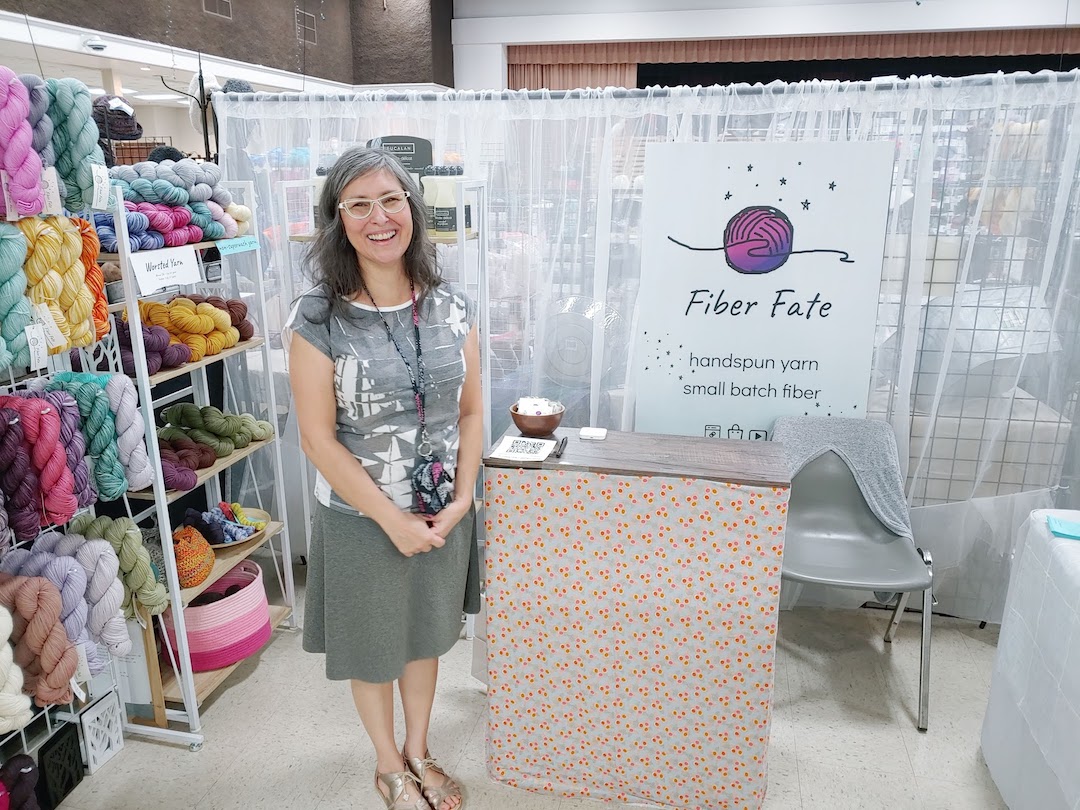

I mean year.
ok, ok, I was feeling a little defeated as of New Year’s Eve eve. Didn’t even come close to what I had envisioned myself getting wrapped up for the year. My End of Year Cram was more like an End of Year Dashed Fiber Hopes. My little experiment of making the end of the year a wool wrap up didn’t really pan out. I won’t ramble on about why. It’s all the same normal reasons. Instead of feeling bad or awkward, I’m just going to keep moving forward. Positive is productive (btw, that’s about as far as I go for inspirational speech’s) and that’s where I want to be going into this new year. Focus on the things I did accomplish and what I have to look forward to going into 2021.
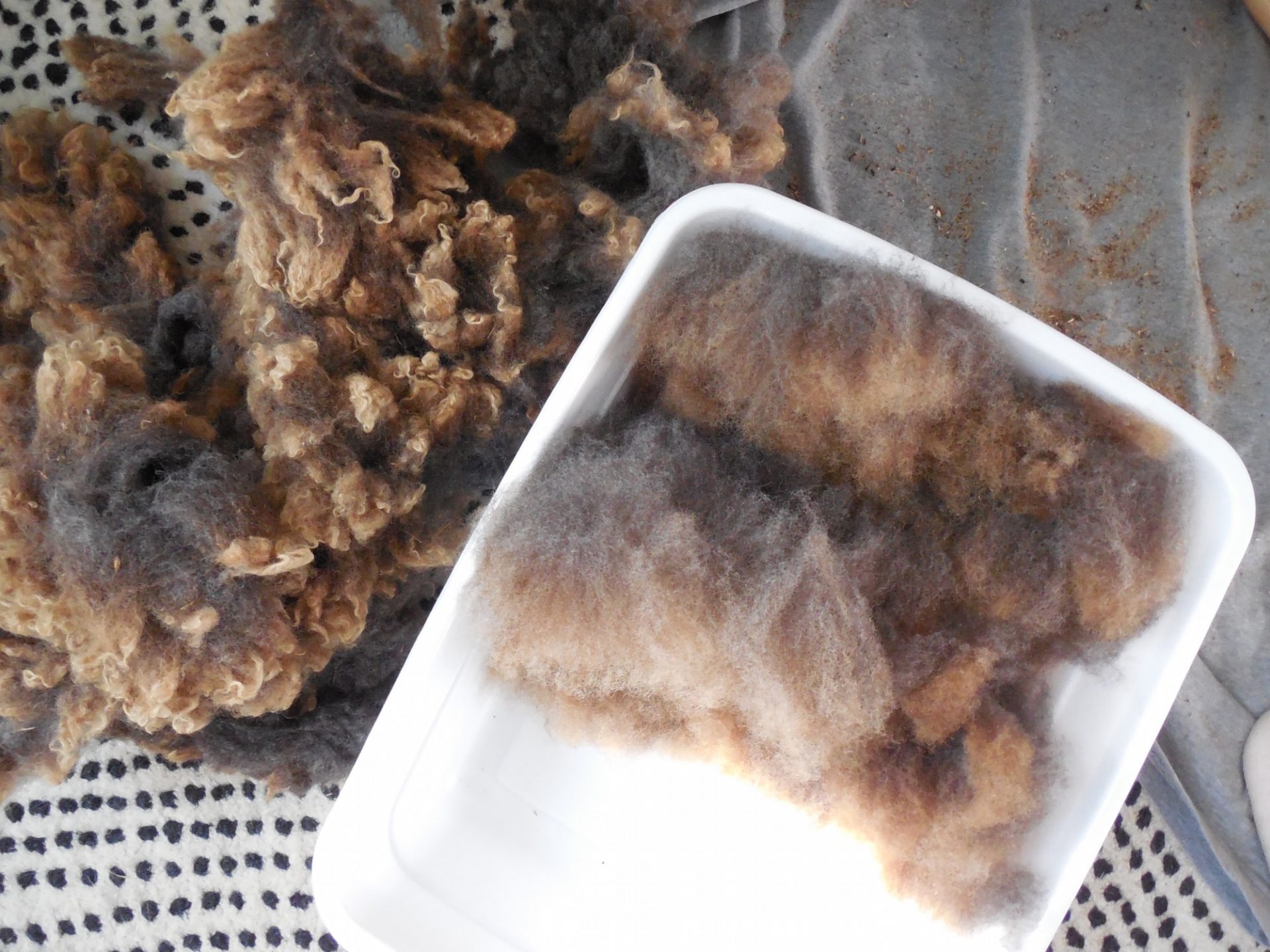
The year ended. Those final hours, were in fact, quiet productive. Hours of spinning and spending quality time with some Harlequin fleece before and in between playing games and enjoying food and desserts with my family – my husband and daughter. That’s a pretty darn great day in my book. Truly a good one – New Year’s Eve 2020 is right up there as one of the best I’ve ever had. All the basics (health and wool included) and good company, what more could anyone ask for.
End of Year Cram successes, albeit small: whittled down a one pound bump of Harlequin roving with four more ounces spun and plied into 2 two ounce skeins. I worked those pink rolags! Those six ounces of fluff are spun into a lovely yarn. I started hacking through some Teeswater locks. Really more like gentle snipping. So unfortunate I felted part of the one pound batch shown in my picture list two posts back. Sad, but still completely useable. The locks felted only at one end, which makes me think I just didn’t prep it properly before washing.
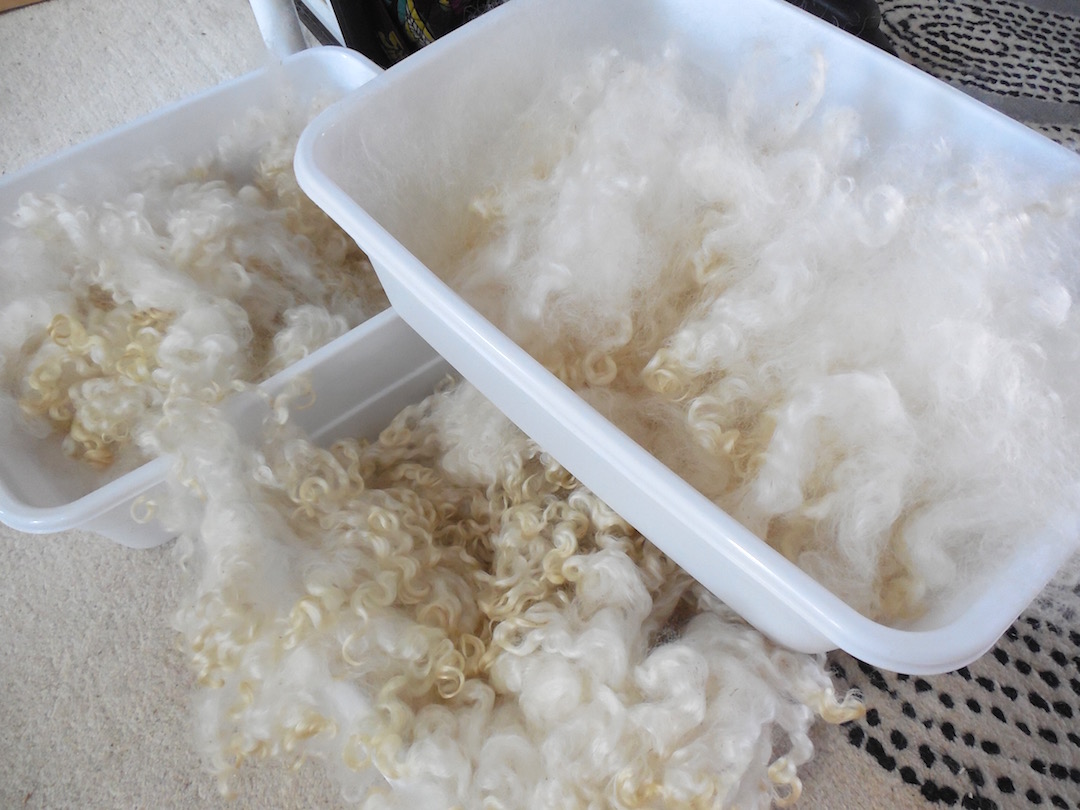
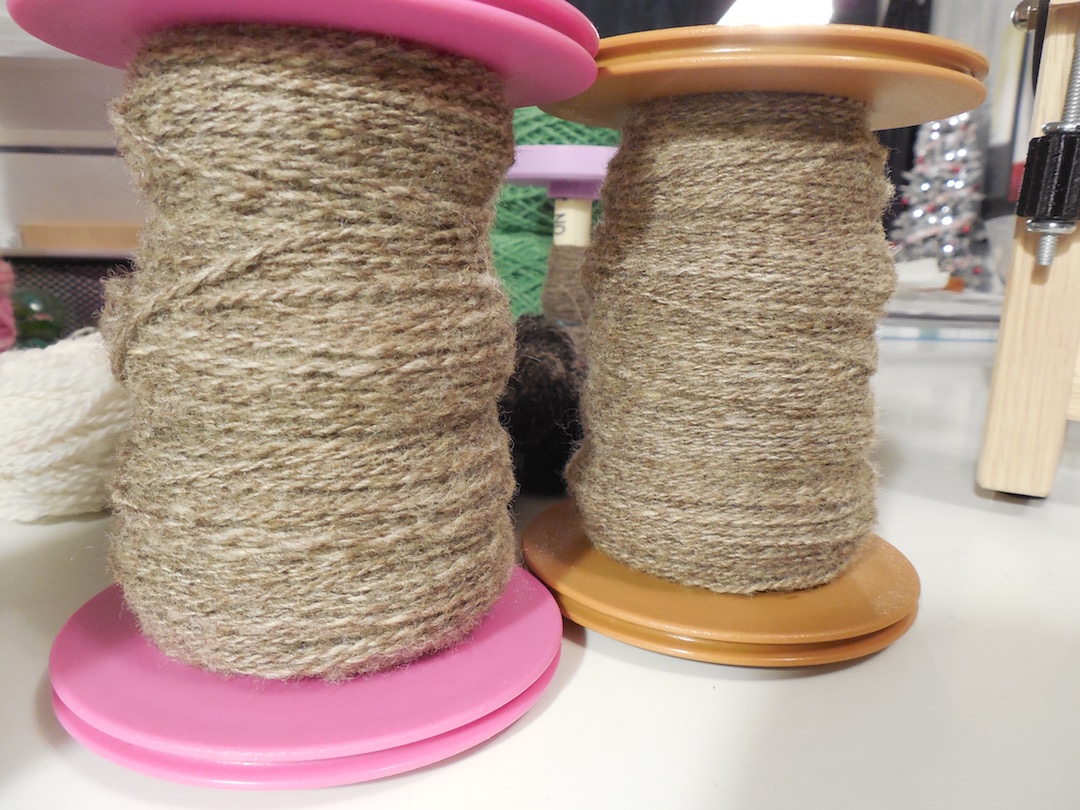
In 2020 I learned how to use support spindles and I started knitting! Knitting is an extra big one since I have been meaning to pick it up for many many years. I have done three whole swatches and entirely made one scarf. So much progress, lol!

Hello 2021, looking forward to learning new skills and honing the one’s I have. I am excited for all the wool and yarns to come. Happy New Year everyone!!
A quick check-in along with some fiber pics. A week and three days ago, I posted about an end of year wrap up on fiber projects. How great it would be to get a few things finished before January. January is usually my wrap up month, but this year, given the virus, I thought why not get some things done in December.
I have so many projects started. Not being that organized at the moment, I didn’t come up with a specific written list for the last three weeks of this month. Using fiber that’s been sitting around the longest makes sense for piecing together a mental list. Looking around my studio …

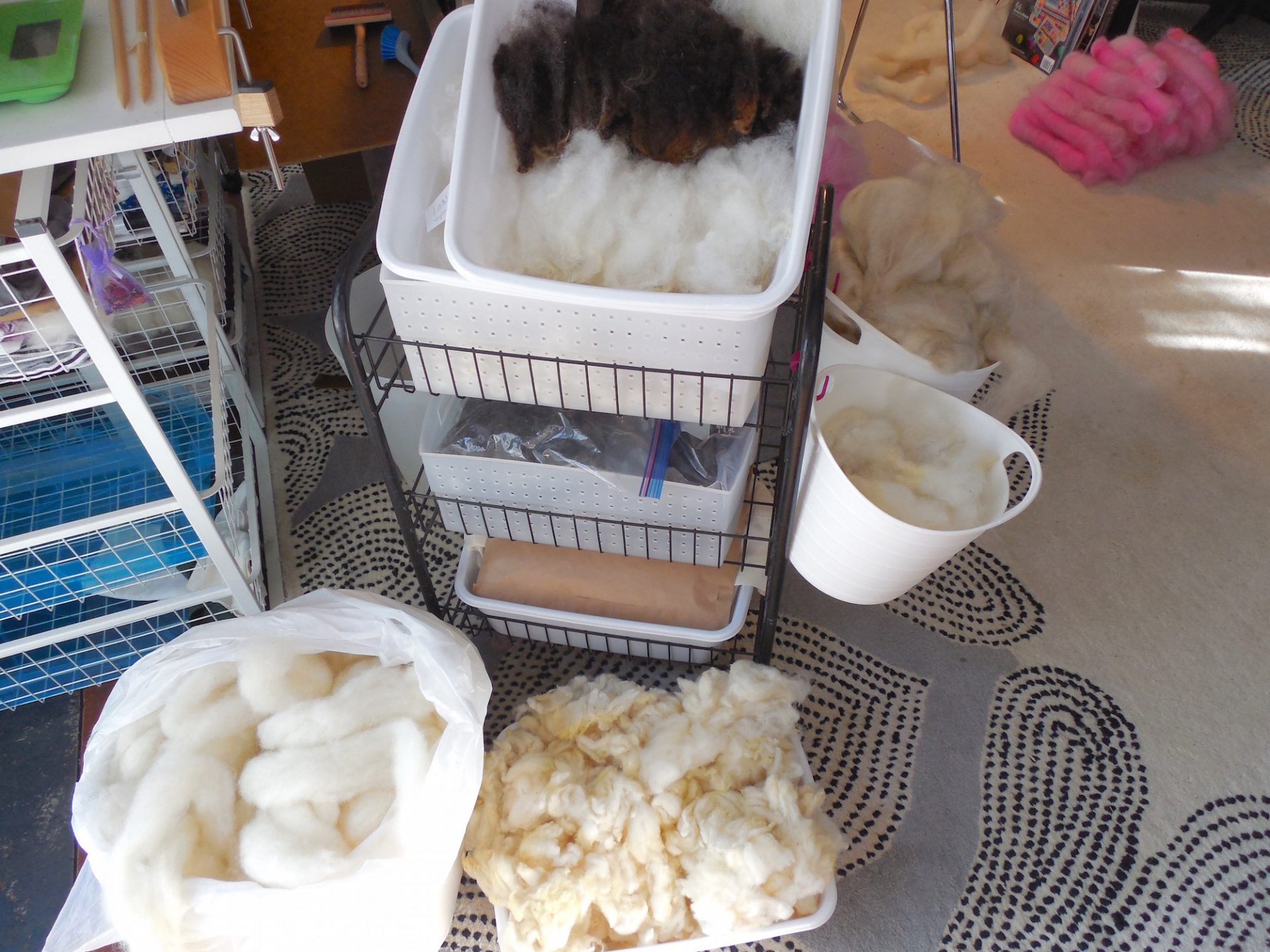
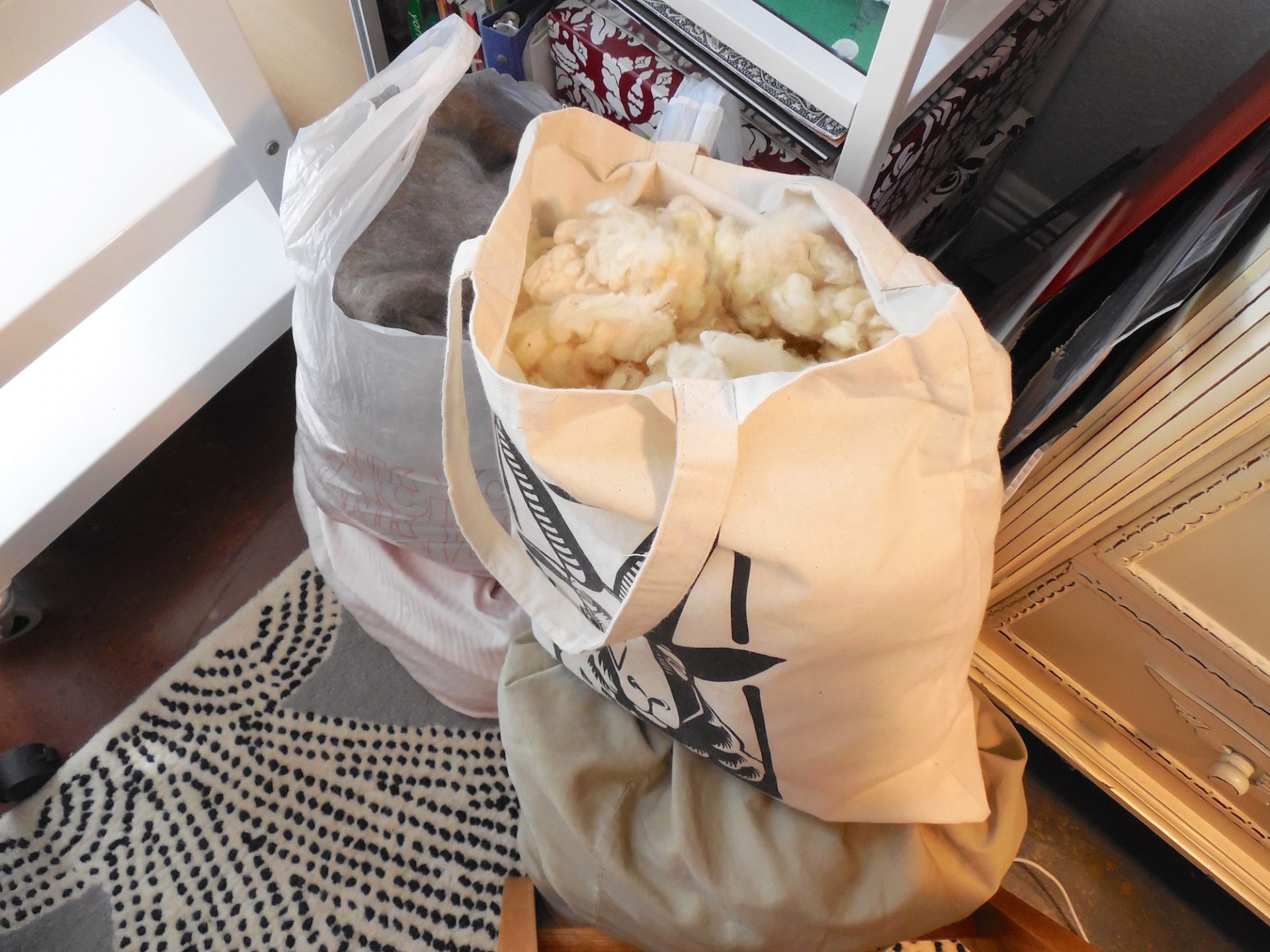
A list in pictures! I like it. Above pictures are a good portion of my currently in progress fiber To-Do’s. Basically in the order I should work on them. That Coopworth fleece has been sitting around the longest (since last year) – because I’m saving it to make a throw blanket for myself. That ALWAYS gets pushed to the bottom of the list of things to do. The Teeswater sitting on top of the Coopworth is roughly half a pound of the one pound washed of the 7 pounds raw that I got early summer this year. Teeswater – I love it, I hate it, I love it, I hate it…
Middle picture is where I actually started last week. I count seven different wools plus those pink rolags sitting on the floor in the back. I started with the round bin hanging on the right toward the back. That’s a Harlequin/mohair mix from sheep and goats in Smithville, Texas, milled into roving at Independence Fiber Mill. That is actually one of my most recent fiber purchases, but I was super eager to dive-in.
Last picture is pillowcase & bag of Southdown (washed last month), 1 bag of gray Harlequin/mohair roving, and last bag unknown (I need to take a peek inside). All piled neatly near my spinning wheel within the last month or so.
10 days and only 5 ounces later… I finally got all the Harlequin/mohair on the bobbins. I guess I should keep in mind for future planning that this is 5 ounces of 1 pound I bought. I am starting with 5 ounces to get a feel for this fiber. I wasn’t entirely sure how I wanted to spin the bulk of it. Or if I wanted to do several different types of yarn. Get a feel for it, I did. I spent at least 3 or 4 times the spin time picking out VM. VM, VM, VM! Must stay calm and work diligently in the midst of Vegetable Matter roving. Oh the challenge, the fine motor skills struggle of little bitty piece picking, the strain to see them all. The worst part is thinking you’re going to whip up a quick yarn, then coming to a sudden holt, for the most part, before it’s even begun. VM, the yarn blocker! *argh* *sigh* It happens… more often than you would think. I have come to think of it as part of the “charm” of working with wool. If there were no challenges, it would be dull. Some wools are just worth all the trouble. This one is going to be great, it’s Harlequin and mohair.
Feel free to share your projects in the comments. I love to hear about what everyone is working on – struggles, successes, mishaps.
Last I wrote, Jacob is great, but didn’t thrill me. I implied the ol’ “it’s not you, it’s me” excuse to not explain anything. Even as I wrote it, I kept asking my self “but, why?”. Why do I feel like this? What’s not to be thrilled about? By all standards of measure, it’s a great fleece. What do I not like about this fleece and maybe Jacob in general? I can’t just go around thinking I dislike a breed without recognizing the reasons why.
I’m fairly new at hand processing wool – about 2 1/2 years of experience. In the world of wool and spinning is not a long time. Especially now, I feel like it’s important to sort out my thoughts about each fleece I process. Sorting out the more technical aspects is pretty easy. Using guidelines of the breed to assess what your working with really gives you an opportunity to learn the breed. Whether your fleece meets all the standard criteria or not, working raw fleece to yarn gives great insight into that breeds wool characteristics.
“Too medium” just keeps running through my head. But really, all that means is I need to put more thought into this. I need to discover just what too medium means. As of my last blog entry, I had only spun a very small sample of this Jacob fleece. It had been right after washing, before I flicked nearly the entire fleece. So often, from even a small sample spin, I get that “ok, I see what this wool is all about”. I really get to the heart of the characteristics – the length, the crimp, the softness or coarseness, the loftiness or silkiness – the combination of characteristics that make the wool special in it’s own right. This fleece did not want to reveal itself right away. Oh the mystery…
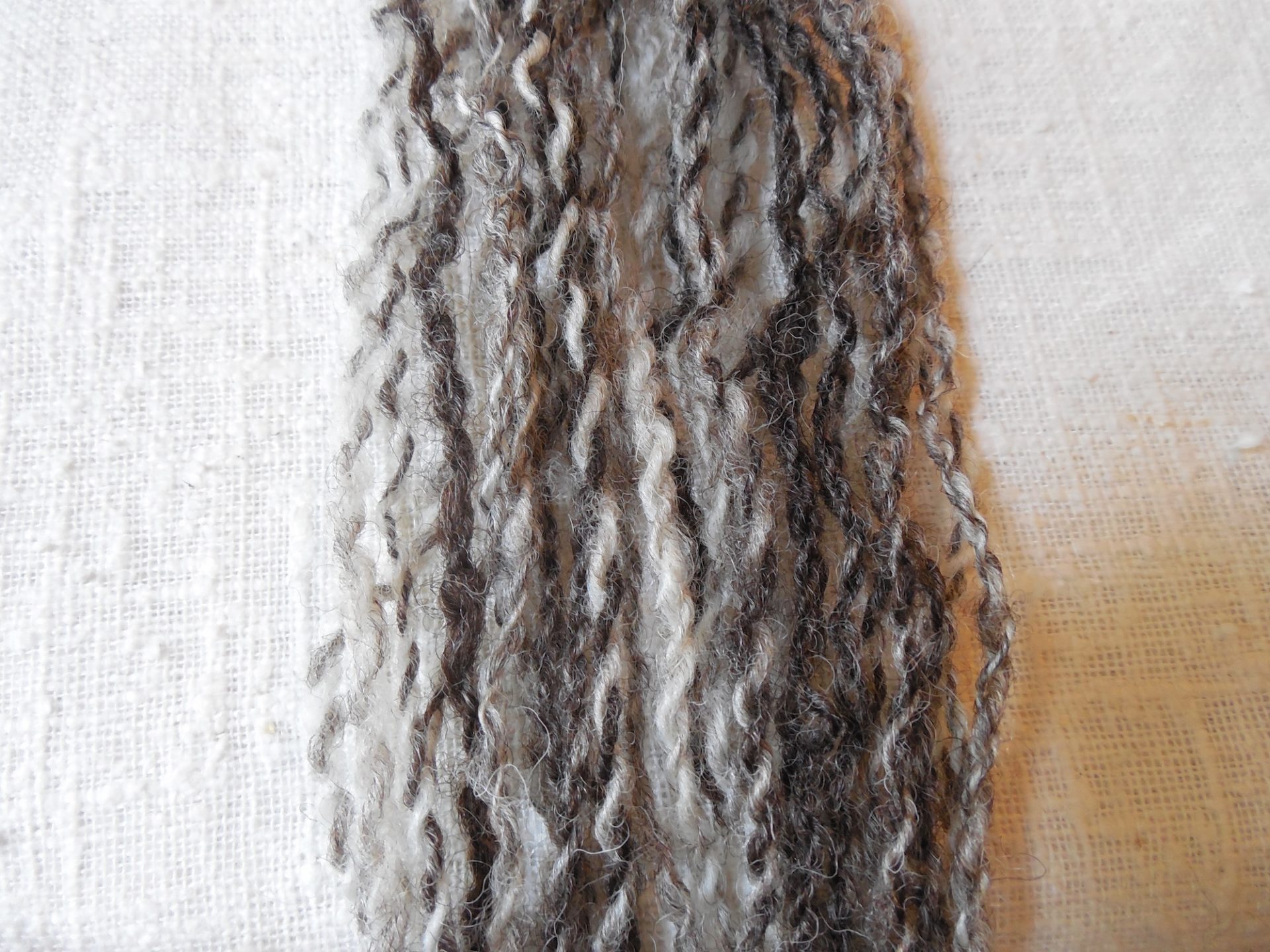
My first mistake was only spinning one little kind of sample. Making a judgement from that, is just not fair. I should know better and I usually do. Normally I sample spin several methods, pull them off the wheel and study them to see which one works best. I have now spun two more samples that are larger in order to get a better understanding. I can still say, this is a Medium wool. In fact, I can’t say that enough.
Flicking: it was deceptive. It looked as though it would flick easily. It was actually quite difficult to get through each lock. No, there was no matting at all. I experimented with two types of flickers and ended up using both throughout. Some of the locks needed a good whacking to loosen up the wool (again, even though it was not matted or felted). The fibers just held together on both the butt and the tip ends. Especially the tip end though. Even the little amount of VM wanted to stick to the fiber. All of my flicking sessions ended with soar and fatigued wrists and fingers.
Carding: this was a breeze. It went easily and smoothly through the drum carder. I have to say, the batts were quite lovely. I did one solid brown and one mixed color. I only put them through once so the multi-colored was purposely blocky.
Spinning: a nice experience. Spinning was pretty effortless. The wool was easy to manage. I spun one in a backwards draft with a sometimes long draw style just to see. The multi-colored batt was spun short forward. Both methods of spinning worked just fine, drafted consistently. Not too slippery and not too grabby. It was soft, but not too soft, had a sturdy handle with just enough grip.
As far as having similar characteristic to a down breed, well, maybe ever so slightly when spun from hand carded rolags, which was my first sample spin. After having just worked a Suffolk fleece, I’d have to say, “eh, not really super down-like”. Downs have sturdy hefty loft. This Jacob’s loft was a bit mushy. But Hey! That’s not to say something bad. Jacob loft is more delicate which can make for some very nice easy moving draping fabric. Also I’d be curious to try a slightly more mature sheep fleece to see if I’d get the same results. Remember, this is a yearling fleece.
The resulting yarn from any of these spins – worsted, semi-woolen, woolen – would work well for all different kinds of projects and garments.
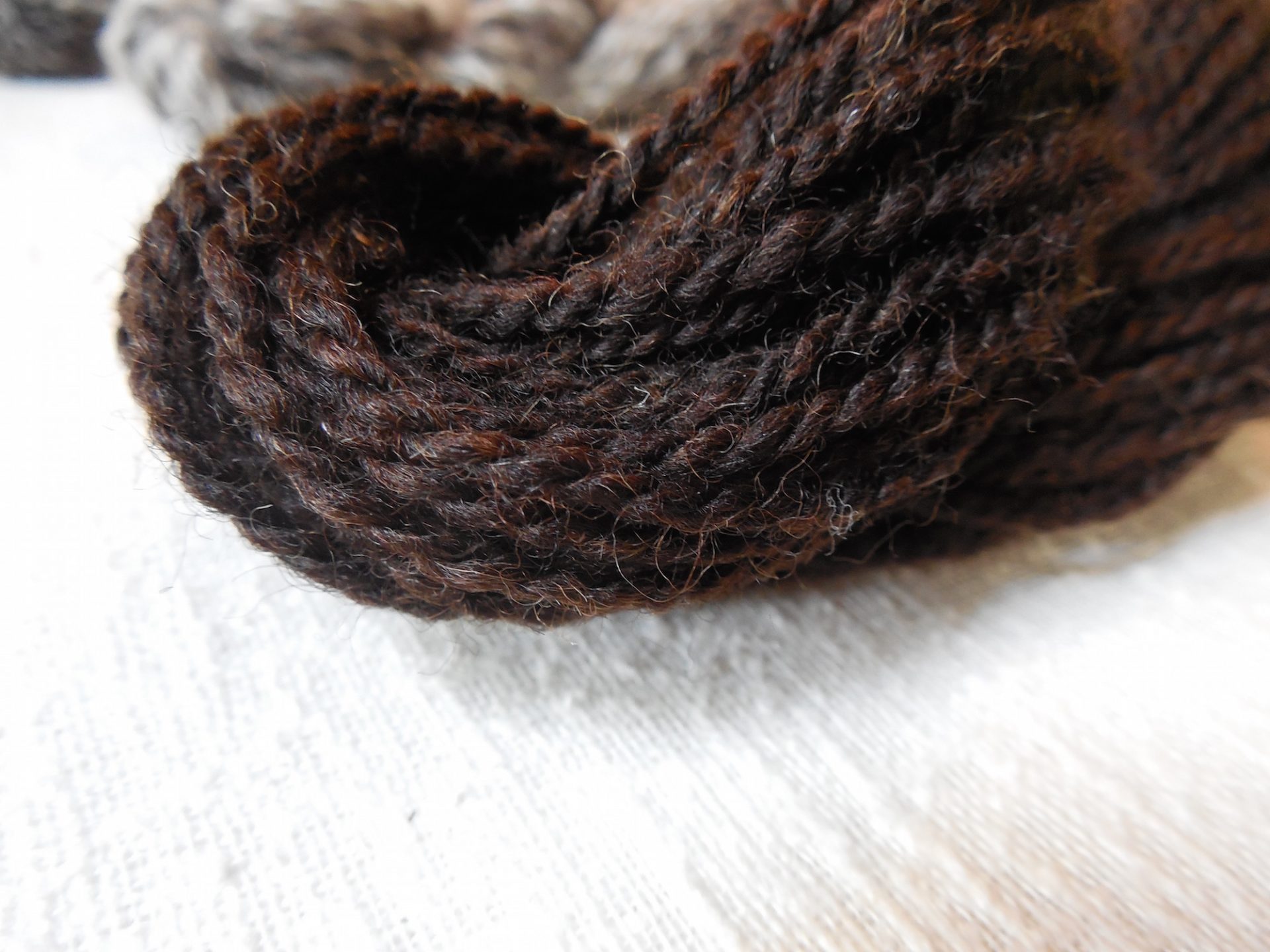
The upside: The dark brown is a rich color that in so very pretty. That dark contrasted with the white really creates a nice pop of color on the multi-colored yarn. You could really get a good variety of color blends with a Jacob fleece. The soft but sturdy nature and medium/low elasticity really makes this yarn very versatile. I am happy with the resulting yarns. My favorite from this fleece is the semi-woolen. Just enough squish to be ultra cozy.
The downside: Obviously, the joint fatigue I experience was a big downer. The VM was hard to get out which means 1) I had to pick at it after flicking, basically it turned into a whole extra step in the processing, 2) it takes a lot longer to get to the fun part of spinning it.
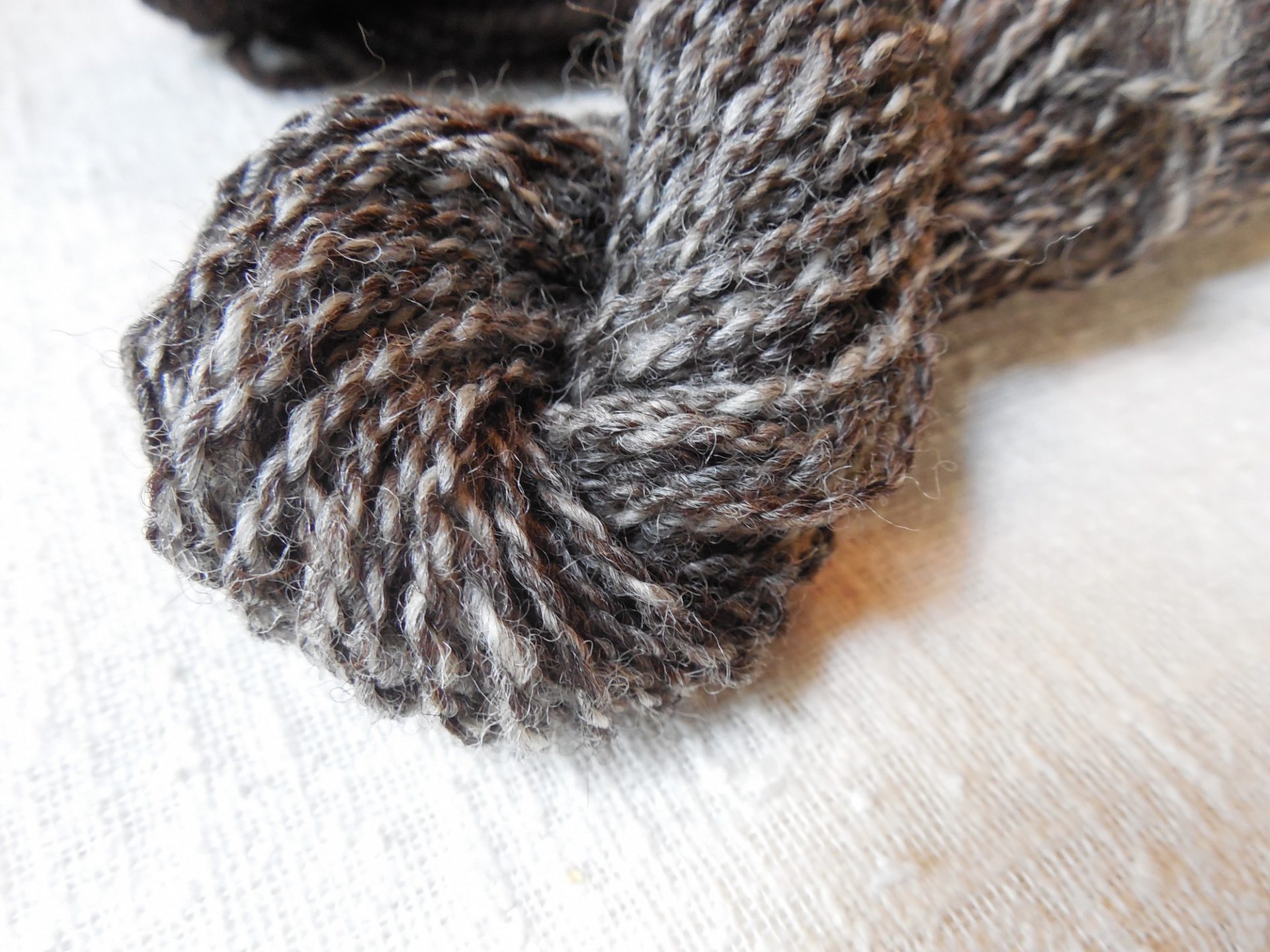
My wow moment did not come until the very very end. After I spun up both of the last samples, took a good look, I finally realized how pretty and functional Jacob yarn is. So often there is an “ah, I love X about this wool” moment early on. When that didn’t happen, I think I unconsciously moved on to my next fleece. Which, by the way, I had just washed. I believe my excitement for the next fleece played a part in my lack of enthusiasm for Jacob. Chalk it up to bad timing. While it’s still not at the top of my list, I like and have a great respect for Jacob. I have come to appreciate the qualities of this wool. It is a nice spin, nothing to technical or annoying about it. The final yarns are quite beautiful.
Have you ever come across a fleece that is captivating? It pleases your wool senses. It inspires possibilities. It begs to be handled. You love it so much that, after washing, you diligently check on it every hour or so to see if it’s dry yet. Deep inside you know it’s really just an excuse to gaze upon it’s loveliness just a few more minutes. The hand, the crimp, the color… the everything…too wonderful for words.
So, Jacob… um…well.. Jacob didn’t do that for me. Don’t get me wrong, it’s great. It’s a good breed with good sturdy wool. It just didn’t thrill me like I thought it would. High expectations (and lack of doing my homework) is so often a downfall. I got this nice fleece from a farm in New York. It is a yearling fleece! The staple length is 4 to 5 inches which falls right into the expected 3″ to 7″ range. It washed up nicely with 3 washes and 3 rinses. It has a nice balance of dark and light colored wool being a piebald (white with dark spots).
Jacob’s have medium soft wool. This one is, for the most part, pretty soft, which you would expect from a yearling. After washing, I dug into a section to start getting a feel for the wool, it was riddled with kemp. Ugh, I was confused and a little worried. Visions of limited-use skeins flashed before my eyes. Oh dear!
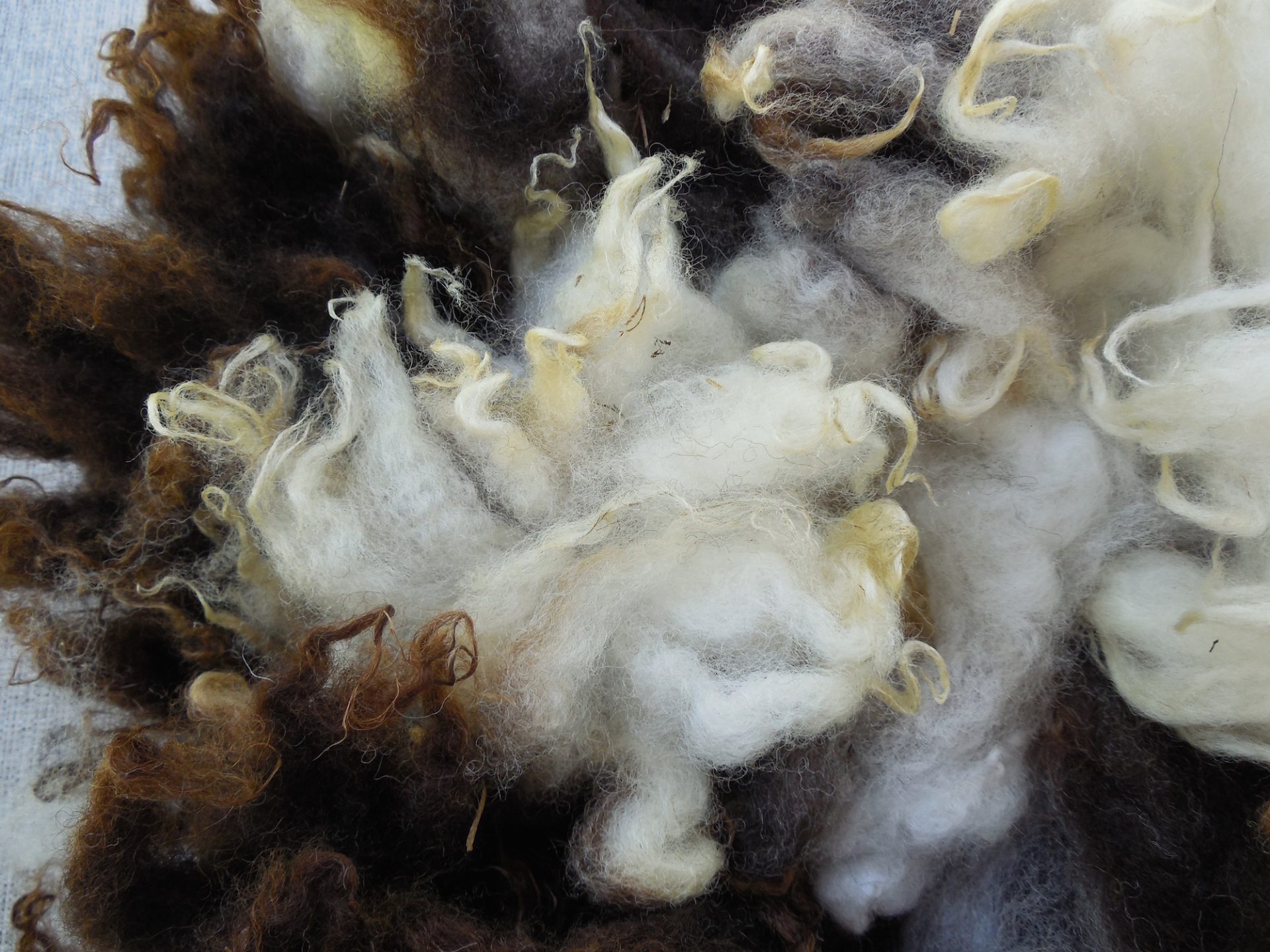
Further investigation revealed it was just that one little area with kemp. Oh, thank goodness! Regarding kemp, I have since read two different things. One, it’s common for Jacobs to have kemp. Two, another source said there should be little to no kemp. Huh. The length is more than great on this fleece. It ranges from 4″ all the way up to 6″ with the bulk of it in the 5″ range. Another common acceptable Jacob trait is varying lengths of wool on each sheep. Often the darker wool is shorter. Jacob fleece is also know to have a nice open structure and light in the lanolin department. It has a down-like quality even thought it is not double coated. It fluffs up with lots of spring when spun. The micron range for the breed is 26-36.
Oh, I almost forgot, one of the main characteristics is the horns. Jacob are polycerates. They have 2 to 6 horns.
A brief history: These charming small framed sheep come from England where they have been very popular for centuries. Beyond the most recent centuries, it is unclear of the original original decent. Some think maybe the area of Syria. Today there are British Jacobs and American Jacobs. Jacobs were imported to the US during the mid 1900’s.
The British decided to breed Jacobs for an even fleece and larger overall body structure. Jacobs in the US have been breed to enhance the quality of wool but leaving other original characteristics the same.
Jacobs are a Heritage or primitive breed. In the United States, they have been put on The Livestock Conservancy conservation list, currently at a “Threatened” status.
Small batches of washed locks and flicked locks are available in my Etsy shop as of the publishing of this blog entry.

Freshly washed and in progress – Suffolk.
This Suffolk fleece came from Black Sheep Gathering in Albany, Oregon. I grabbed it at the last minute on my final pass through the fleece market. The breed was not marked, but it was dense, fluffy, nice crimp, not terribly dirty, and in my price range considering I just spent a boat load of money at the market and already purchased two other big raw fleeces.
After months, I finally got around to sending a couple of emails to find out exactly what kind of sheep this lovely fleece came from. A very nice coordinator at BSG contacted the ranch where “Bella” resides. Heard back, Suffolk! Suffolk was not on my “learn more about” radar. I hadn’t ever even considered it. I am so glad I grabbed this fleece. I love it.
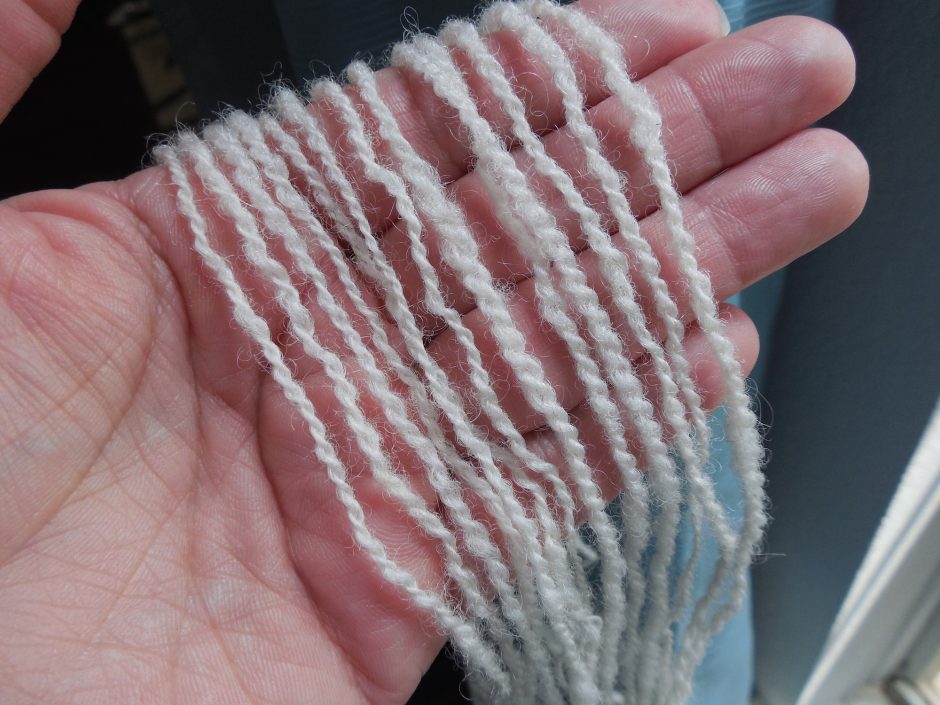
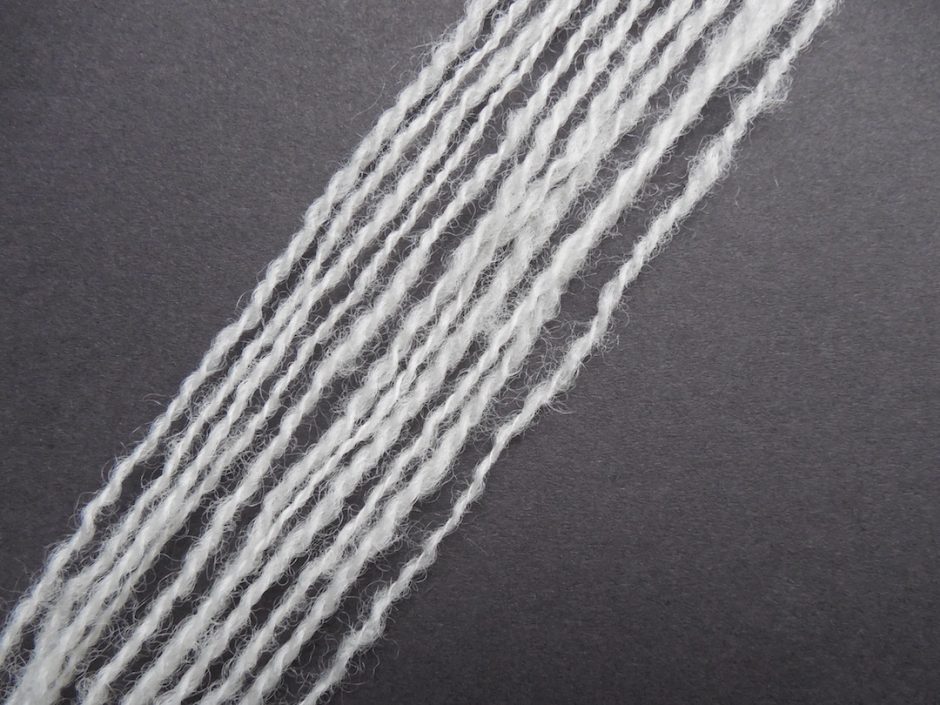
It was a real pleasure to wash. Most of the dirt came off in a pre-soak. The lanolin came off with one wash. Beautiful fleece with half the wash work! It’s a nice white and has all the characteristics you expect from the breed.
Suffolk is a down breed. This fleece is medium, slightly on the softer side of medium. It cards up wonderfully on the drum carder and hand cards. The first quick sample yarn I spun straight from a lock, separated with my fingers and spun on a wheel (a). I get so eager to test once a fleece is washed and dry! I spun an extra nice lock on a support spindle as well – teased by hand (b), it was easy and nice spinning (note: Don’t judge my sample too much. It was a grab and go situation. Spun to test the wool, not make a perfect yarn.). The last sample, which I just spun up yesterday, is from roving I made on my drum carder (c) and (c2).
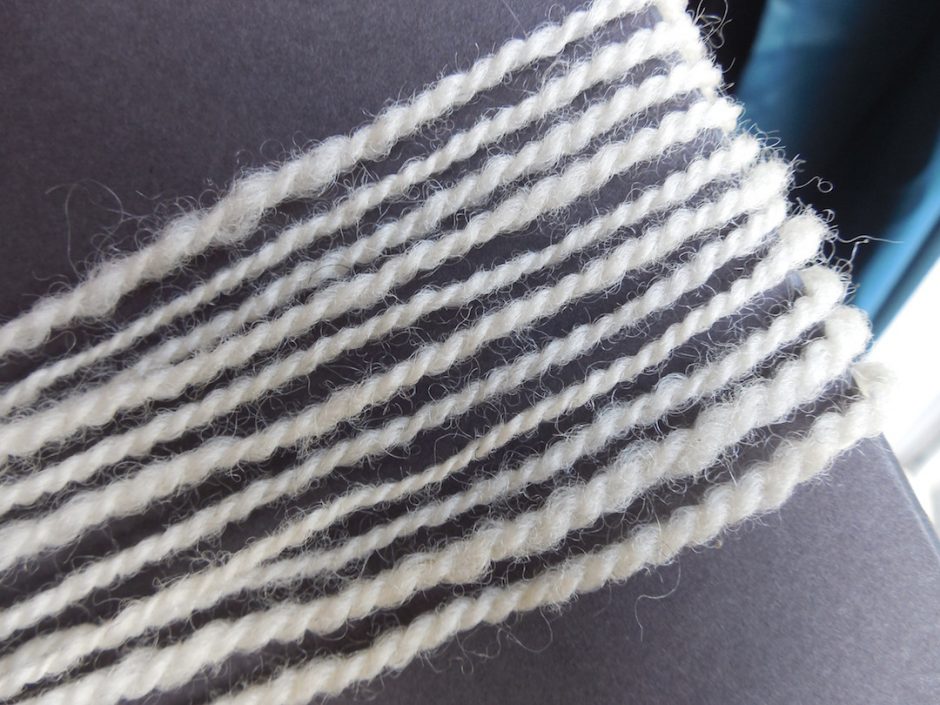

I have three small batches (6 ounces each) of this washed fleece in my Etsy shop. Coming up, I’ll have either batts or roving available as well. Feel free to contact me via email if Etsy isn’t your thing.